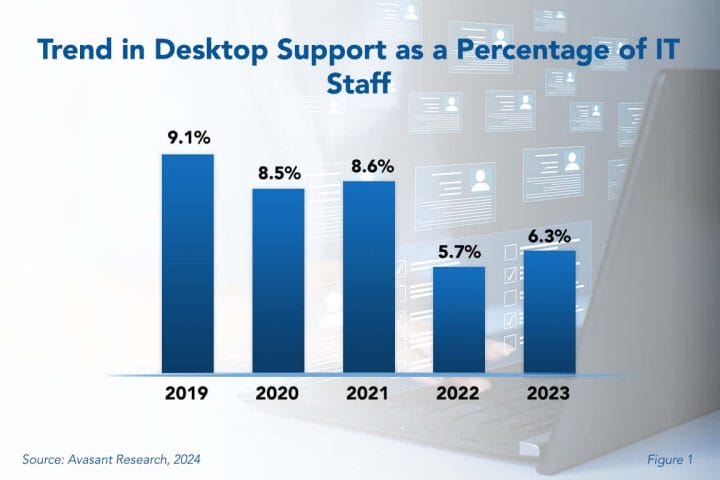The desktop support function has gone through significant disruption in recent years. Digital workplace technologies and the need to secure employee-owned equipment have put a strain on this function. At the same time, automation and other influences have made desktop support more efficient, and staff less necessary.
As shown in Figure 1 from our full report, Desktop Support Staffing Ratios, the desktop support staffing levels across all organization sizes ticked up to 6.3% at the median in 2023, which is up from 5.7% in 2022. Nevertheless, this ratio is still below pre-2022 levels. The decline could indicate that fewer support staff are needed to maintain end-user equipment. However, security demands, remote work, and proactive support models could reverse this trend in the long run.

“One of the major themes reshaping this environment is a change toward proactive assistance,” said Asif Cassim, principal analyst for Avasant Research, based in Los Angeles. “While it may not necessarily result in additional desktop support staff, it may require new roles for support staff and some upskilling.”
For IT organizations, it is critical to understand how many desktop support personnel are needed to service the company’s users. The desktop support staff not only plays a key role in maintaining user productivity, but along with the help desk, it also serves as the face of the IT organization. Because of integral end-user demands, a well-run desktop support function can greatly aid the perception of the IT department throughout the enterprise.
Desktop support refers to all technical support activities related to user systems, including desktop computers, laptops, mobile devices, and workstations of all types. In most companies, these include activities such as building or setting up new machines, initial installation of operating systems and standard application software, applying periodic updates and security patches, replacing and disposing of obsolete equipment, monitoring usage, and responding to user-reported incidents. In many cases, desktop support personnel may also support printers, LANs, digital whiteboards, telephones, conference room projectors/displays, point-of-sale systems, or other end-user equipment. We include all these functions within the scope of desktop support—an antiquated term that nevertheless is still widely used.
Our full report provides benchmarks on typical desktop support staffing. We use four metrics to benchmark desktop support staffing: desktop support staff as a percentage of the IT staff, PCs per desktop support staff member, applications per desktop support staff member, and users per desktop support staff member. We also assess these ratios by organization size and sector. In addition, we provide benchmarks for organizations with combined desktop support, help desk, and IT training/documentation functions. We conclude with strategies for improving the efficiency of desktop support staff.
This Research Byte is a brief overview of our report on this subject, Desktop Support Staffing Ratios. The full report is available at no charge for subscribers, or it may be purchased by non-clients directly from our website (click for pricing).

